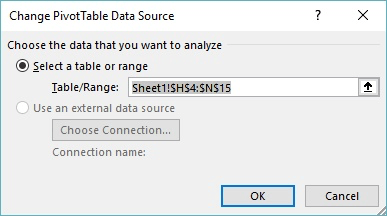Please Note: This article is written for users of the following Microsoft Excel versions: 2007, 2010, 2013, 2016, 2019, 2021, 2024, and Excel in Microsoft 365. If you are using an earlier version (Excel 2003 or earlier), this tip may not work for you. For a version of this tip written specifically for earlier versions of Excel, click here: Missing PivotTable Data.
Written by Allen Wyatt (last updated September 6, 2025)
This tip applies to Excel 2007, 2010, 2013, 2016, 2019, 2021, 2024, and Excel in Microsoft 365
Imagine this scenario—you are working with an Excel workbook created by someone else. The workbook contains a PivotTable, but you discover that you cannot make changes to it. When you try, you get a message that says the underlying data was not saved. The worksheet with the data is in the workbook, and the PivotTable is there, but you cannot change the PivotTable directly or even make changes to the worksheet and updated the PivotTable.
This scenario isn't that unique; it happens all the time. There are two possible reasons for the problem. First, when a PivotTable is created, the user can specify an option that causes Excel to not save the data with the table layout. (This option is accessed by clicking the Options button on the last step of the PivotTable Wizard.) If the PivotTable is really based on the worksheet in the workbook, then this is no problem. If, however, it is based on some other data source, then it can cause a problem because you cannot later modify the table.
The second possible reason is that the workbook that you have isn't the same workbook in which the worksheet and the PivotTable originally resided. It is possible that, in creating the workbook for your use, the original user copied the PivotTable and the worksheet from the original workbook to a new, blank workbook. If this is the case, then the PivotTable is independent of any data in the workbook you are viewing. You can check this out by trying these steps:

Figure 1. The Change PivotTable Data Source dialog box.
Excel redoes the PivotTable, this time based on the information in the workbook. You can then make changes to the PivotTable (or the underlying data) as you desire.
ExcelTips is your source for cost-effective Microsoft Excel training. This tip (8391) applies to Microsoft Excel 2007, 2010, 2013, 2016, 2019, 2021, 2024, and Excel in Microsoft 365. You can find a version of this tip for the older menu interface of Excel here: Missing PivotTable Data.

Create Custom Apps with VBA! Discover how to extend the capabilities of Office 365 applications with VBA programming. Written in clear terms and understandable language, the book includes systematic tutorials and contains both intermediate and advanced content for experienced VB developers. Designed to be comprehensive, the book addresses not just one Office application, but the entire Office suite. Check out Mastering VBA for Microsoft Office 365 today!
When you want to include specific records from a source table into a PivotTable, you need to employ some sort of ...
Discover MoreYou can configure Excel so that it displays special text within blank PivotTable cells. Here's how to make the changes ...
Discover MoreIf you are using a data set that includes a number of zero values, you may not want those values to appear in a ...
Discover MoreFREE SERVICE: Get tips like this every week in ExcelTips, a free productivity newsletter. Enter your address and click "Subscribe."
There are currently no comments for this tip. (Be the first to leave your comment—just use the simple form above!)
Got a version of Excel that uses the ribbon interface (Excel 2007 or later)? This site is for you! If you use an earlier version of Excel, visit our ExcelTips site focusing on the menu interface.
FREE SERVICE: Get tips like this every week in ExcelTips, a free productivity newsletter. Enter your address and click "Subscribe."
Copyright © 2025 Sharon Parq Associates, Inc.
Comments